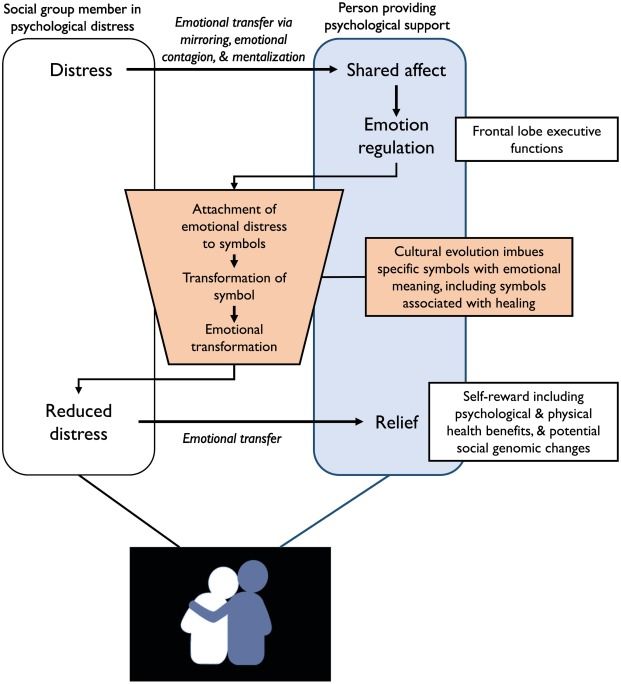Trauma
How We Help Each Other Heal
Much of our healing can take place in relation to others.
Updated April 25, 2024 Reviewed by Gary Drevitch
Key points
- The effects of others on our biology are well-documented by research.
- There are evolutionary origins to why humans provide psychosocial support to each other in times of need.
- A crucial driver of healing in relation is in the quality of our connection to others.

Pain, in its many guises, is a mandatory feature of the human experience. Often, we feel alone in our pain. Yet, belonging to our highly social species offers an invaluable resource for coping with it: other people.
The effects of others on our biology are well-documented. Someone’s presence can affect another’s breathing, heart rate, and chemicals in their bloodstream. A mother’s soothing voice can stabilize her preterm infant, leading to fewer cardiorespiratory events. A spouse’s hand-holding can reduce the neural response to the threat of electric shocks. Supportive relationships can help us live longer and happier lives.
Our brains and their bonds
As we go about our days, our brains are secretly working with other brains, writes neuroscientist Lisa Feldman Barrett in Seven and a Half Lessons About the Brain (2020). We do this by regulating each other’s “body budgets,” which are the ways our brains manage various biological resources such as water, glucose, salt, and oxygen, in service of keeping us alive and well. With our interactions, we make deposits and withdrawals to and from each other’s body budgets, gradually “tuning and pruning” our neurons. Your loving hug to your friend can add to her budget. A hurtful insult from a colleague might take away from yours.
“Ultimately, your family, friends, neighbors, and even strangers contribute to your brain’s structure and function and help your brain keep your body humming along,” Feldman Barrett writes.
Evolutionary origins of psycho-social healing
According to researchers, 3 key ideas help explain why humans, throughout centuries and continents, have facilitated each other’s healing with their psycho-social support for each other:
- There are evolutionary origins to why humans experience emotional distress. Emotions, including those associated with distress (e.g., grief, shame, fear, anger), partially evolved as responses to interpersonal dynamics, either for approaching opportunities for survival or avoiding threats to life (Kohrt et al, 2020).
- Emotions and emotion regulation evolved in a social context. Since emotions evolved not in isolation, they can be regulated both within an individual (self-regulation) and between individuals (interpersonal regulation) (Kohrt et al, 2020).
- As we partake in interpersonal regulation of emotion, various mechanisms facilitate consoling behaviors. These mechanisms include empathy, perspective taking, mentalization and emotional contagion (Kohrt et al, 2020).
Psychological distress, write Kohrt et al., (2020), can often signal the need for repairing social ruptures or disrupted social bonds. As a “restorative mechanism,” we partake in a variety of social repair behaviors by consoling, comforting, and supporting each other.
At the heart of most of these behaviors that facilitate interpersonal regulation is empathy, with its two underlying systems: emotional contagion and cognitive perspective-taking (mentalizing).

Words matter
We do a lot of our intrapersonal and interpersonal regulation through words.
Think of the last time words that you heard, read, or uttered changed the landscape of your inner experience – from softening you with safety to clenching you with rage.
According to Feldman Barrett, the reason why words affect us so deeply is because the “language network”—the brain regions that process language—“also control the insides of your body, including major organs and systems that support your body budget.” These brain regions regulate heart rate, modulate glucose intake for cell energy, and influence chemicals in the immune system.
This makes words—the sentences we utter day after day, to ourselves and to others, mindfully or mindlessly—“tools for regulating human bodies,” she writes:
Other people’s words have a direct effect on your brain activity and your bodily systems, and your words have that same effect on other people. Whether you intend that effect is irrelevant. It’s how we’re wired. (Feldman Barrett, 2020).
Collective healing
As an expert in collective trauma—the psychological reactions to a traumatic event that affect an entire society (Hirshberger, 2018)—Thomas Hübl has facilitated programs with over 100,000 participants across the world and authored two books on how adversity affects us and how we heal from it.
According to Hübl, since most of us carry fragments of collective trauma, a key part of our healing takes place in relation with others.
It’s in relation where seeing our own cognitive, emotional, and behavioral patterns becomes easier. And it’s in relation where we gain access to collective wisdom and intelligence.
In fact, separation, othering, and fragmentation—when we no longer share the relational space with others—are symptoms of trauma, according to Hübl.
A crucial driver of healing in relation is in the quality of our connection to others. Attunement, which Hübl describes as a “moment-to-moment process of feeling and listening to each other deeply, as a whole-body experience” is a building block of relating. By signaling safety, it nourishes the interacting individuals and their relationship. “The more attuned relational environments we create, the more we contribute to the self-healing mechanism of the world,” says Hübl.
These “self-healing mechanisms” are also inherent to healthy relational ecosystems – our networks of family, friends, and colleagues. According to Hübl, these networks are an extension of our immune systems. As a practice to foster both individual and collective well-being—“The individual is the ecosystem”—Hübl suggests reflecting on the various relational ecosystems that we are a part of.
What’s uplifting and joyful about them? What feels heavy and draining? “Pay attention to what you don’t want to look at, and what draws you in," he writes. "Start with creating an awareness, without immediately striving for solutions.”
Just as pain can be an unwitting companion we keep running into on our journey, so can healing. The more we engage with the latter, individually and collectively, the more it leaves us its many gifts. It might even become a part of our purpose.
“Our responsibility is not only horizontal—towards people who we live now—but also vertical—towards the past (our ancestors), and the future (our children),” Hübl points out. “What we carry unconsciously, we pass on to the next generation. What we make conscious and integrate, we don’t pass on, which means our children get a bigger world to grow into. Thus, by doing the work we need to do, we increase the possibilities of the future for our children and grandchildren.”
Many thanks to teacher, author and facilitator Thomas Hübl for his time and insights. His latest book is Attuned: Practicing Interdependence to Heal Our Trauma—and Our World (2023).
References
Kohrt, B. A., Ottman, K., Panter-Brick, C., Konner, M., & Patel, V. (2020). Why we heal: The evolution of psychological healing and implications for global mental health. Clinical Psychology Review, 82, 101920.
Barrett, L. F. (2020). Seven and a half lessons about the brain. Houghton Mifflin.
Filippa, M., Panza, C., Ferrari, F., Frassoldati, R., Kuhn, P., Balduzzi, S., & d'Amico, R. (2017). Systematic review of maternal voice interventions demonstrates increased stability in preterm infants. Acta Paediatrica, 106(8), 1220-1229.
Coan, J. A., Schaefer, H. S., & Davidson, R. J. (2006). Lending a hand: Social regulation of the neural response to threat. Psychological science, 17(12), 1032-1039.
Breggin, P. R. (2015). The biological evolution of guilt, shame and anxiety: A new theory of negative legacy emotions. Medical hypotheses, 85(1), 17-24.
Hirschberger, G. (2018). Collective trauma and the social construction of meaning. Frontiers in psychology, 9, 1441.
Taylor, M. (2020). Collective trauma and the relational field. The Humanistic Psychologist, 48(4), 382–388.




